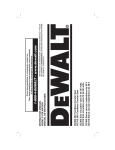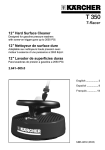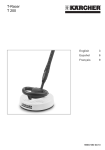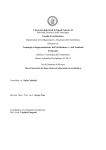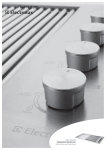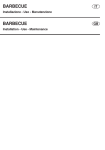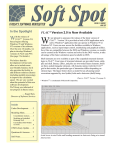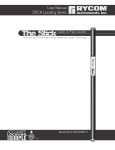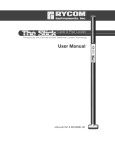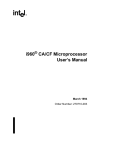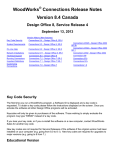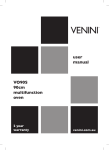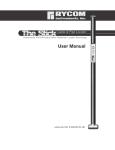Download Computer Design Of Beams, Joists, and Rafters
Transcript
ConstructionCalc, Inc Computer Design of Beams, Joists, and Rafters Computer Design of Beams, Joists, and Rafters By: Tim K. Garrison, P.E. ConstructionCalc, Inc 3705 E. College Way Mount Vernon, WA 98273 360-419-9964. [email protected] Lecture Notes ABSTRACT: In this course you will learn how to design simply supported beams, joists, and rafters using a PC with ConstructionCalc’s Wood Beam Calculator program. The exam quiz consists of actually designing two complicated bending members. Specific items covered include: • Determining snow, live, and dead loading • Determination of span and tributary width • Allowable deflection criteria and its impact on final design • Inclusion of self-weight in the design • Lateral bracing requirements for bending members • Uniform loads, partial uniform loads, point loads, and wedge (triangle) loads • Interpreting output information • Choosing the most efficient solution alternative PREREQUISITES: • This course is written specifically for ConstructionCalc’s Wood Beam Calculator software. Purchase of this software is strongly recommended ($79 via internet: www.constructioncalc.com). You must have a PC with Microsoft Excel 97 or later to run ConstructionCalc software. The course may be taken using other software, however, the lecture notes and quiz are geared specifically for ConstructionCalc’s Wood Beam Calculator, thus passing the quiz without it will be difficult. • It is highly recommended (though not required) you take the online course, “Beams, Joists, and Rafters – Practical Bending Member Theory” by Tim K. Garrison, P.E. as a prerequisite to this course. Certain technical terms pertaining to bending theory, such as allowable stresses, shear, moment, deflection, etc., are used herein without definition or explanation. 1. Simply Supported (Simple) Bending Member. This course only deals with simply supported (or ‘simple’) bending members. They are those beams, joists, or rafters that are supported only at their ends, i.e. do not have interior support(s) or cantilevers. The end connections of a simple bending member must not be rigidly fixed against rotation, i.e. they must not be moment-resisting. Cantilevered and continuous bending members are considerably more complex to understand and analyze for the following reasons: 1.1. They have negative moments, which prompt non-typical bracing requirements to maintain lateral stability. 1.2. The worst case loading condition is normally NOT the full load situation. Unbalanced live loads CDBJR-1 ConstructionCalc, Inc Computer Design of Beams, Joists, and Rafters must be applied to check for worst case conditions. 1.3. Bending member continuity over an interior support adds about 25% more load to that interior support than if the bending members over were simple members. 1.4. Continuous bending members can have uplift at their ends. Bending members with short cantilevers, say less than two feet, without any significant point loads on the cantilevered ends can safely be modeled as simply supported by ignoring the cantilever. Beware however, if designing a beam to support such cantilevered member(s), the cantilevered ends must be included in the determination of the load to the supporting beam. 2. Automatic / Manual Modes. This ConstructionCalc program gives you the choice of automatic calculation after every input; or manual mode, which calculates only when you click ‘Calculate Now’. Make your selection with the checkbox in the upper-right corner of the sheet. The automatic mode can be slow, depending on the speed of your computer. Manual mode allows rapid input, but you must click ‘Calculate Now’ when your input is finished. There is a red warning note that appears reminding you to recalculate after you’ve made a change. 3. Lateral Bracing. ConstructionCalc’s Wood Beam Calculator assumes the member is well-braced against buckling sideways (lateral buckling). In general, a bending member’s strength goes down if it is not constrained against flopping over sideways, i.e. not laterally braced. Lateral bracing need only be applied to the compression side of the bending member. With simple bending members, the compression side is always the top of the member when supporting gravity (downward) loads. Most bending members support a floor or roof system, and thus are well braced laterally by default. If you ever design a bending member that is NOT braced against lateral buckling, you must make sure that variable is included in the design. Most basic beam software programs (ConstructionCalc’s included) do not allow for this. So in the rare case when you are designing a simple bending member with a point load in the middle, say, not connected to anything else, you will have to either add lateral bracing, or design it using hand methods or other, more sophisticated software. What constitutes lateral bracing? Continuous connection to a plywood or other structural diaphragm is the best. Next best is connection to joists or rafters at some regular spacing – typically 24” or less. This connection may be via framing hangers, or simply having the joists / rafters nailed or screwed to the top of the member being designed. In the absence of the above, perpendicular ‘strong backs’, or bridging can be used to laterally support the compression flange. The maximum recommended spacing for such lateral support is at each end of the member being designed, and at every six foot interval along its length. 4. Span. Span is the length in feet from inside to inside of bearing points. For the purposes of this course, and with most beam sizing software, span is measured horizontally. For sloping rafters, make sure the dead load is adjusted higher to account for the slope. CDBJR-2 ConstructionCalc, Inc Computer Design of Beams, Joists, and Rafters 4.1. Example 1: A 10'-6" horizontal beam on 2x6 plates has a span of 10.5 - .46 - .46 = 9.6 feet. 4.2. Example 2: A sloping rafter at 12:12 pitch who's true length between supports is 14' will have a span of 9.9 ft. If the basic dead load was 15 psf, you would use a dead load of 21.2 psf in the loads input section. You need trigonometry or ConstructionCalc’s Loads Calculator program to calculate this. The general trigonometric equation is: dead load on horizontal projected area = dead load/cos(atan(pitch/12)). For our example, 15/cos(atan(12/12)) = 21.2 psf. 5. Allowable Deflection. Deflection is the maximum sag the member experiences under load. It is normally measured in inches. Most building codes are concerned with two categories of deflection: live load and total load. Live load deflection is the maximum sag under live load only, and is normally limited to L/360 (member length in inches divided by 360). Total load deflection is the maximum sag under full loading, and is normally limited to L/240. These standard deflection limits help ensure the member won’t sag so much as to crack or otherwise distress drywall, windows, trim, etc. which are attached. Also, floors which meet this criteria should not feel overly bouncy. Interestingly, deflection is NOT a strength issue; it is an issue of comfort and aesthetics. So a system that fails minimum deflection criteria may still be plenty strong for its application. Many times a designer will want a stiffer, less bouncy system than minimum code prescribes. If so, the allowable deflection should be adjusted accordingly. For example, if you were designing a floor joist which you wanted to feel rock-solid when walked upon, you might decrease the allowable live load deflection to L/600 and total load deflection to L/480. Note an increase in the denominator results in a decrease in the allowable deflection. Likewise if you were designing some beam for an industrial application, say, where appearance and comfort did not matter, you might adjust allowable deflections to L/100. In doing so, you would almost be guaranteeing the member’s design would be controlled by strength, not deflection limits. 6. Load Duration and Load Combinations. Building codes recognize that structural materials behave better under short term loading. For example, a structural system may be able to withstand a temporary overload from construction materials stacked thereon, but may ultimately fail from a permanent dead load of the same magnitude. To account for this, building codes allow a member’s allowable stresses to be increased if the load duration is short. ConstructionCalc software accommodates the following load durations: • Permanent (Dead) for members loaded with dead load only, or members loaded with permanent live loads such as permanent book cases or permanent filing cabinets. This actually results in a 10% decrease of certain allowable stresses. • Ten Years (Live) for members subjected to normal live loads only, such as typical floor joists or beams that do not also support roof loads. This results in neither an increase or decrease in allowable stresses. CDBJR-3 ConstructionCalc, Inc • Computer Design of Beams, Joists, and Rafters Two Months (Snow) for members who's primary live loading is from snow, such as roof rafters or beams supporting trusses or rafters. For members that carry floor loads and roof (snow) loads, if a substantial portion of the loading is from the roof, it is okay to use Two Months (Snow). If most of the load is from the floor however, it is safer to use Ten Years (Live). Selection of this duration results in a 15% increase in certain allowable stresses. • Seven Days (Const) for members who's worst case live loading will be from short term construction loads. For example this is appropriate for roof rafters or beams supporting only roof rafters or trusses in areas of no snow. Selection of this duration results in a 25% increase in certain allowable stresses. Note wind and earthquake are not included in the above list. If you were designing shear walls or moment resisting frames, this duration would definitely be applicable. However, this type of live load is almost never applied to simple bending members, so it has been omitted. If a member is subjected to both roof and floor loads, for example a floor beam also supporting a bearing wall extending to a roof, how can you be sure which duration of load to use? You are always safe (conservative) with the longer load duration. However, as a result you may overdesign the member, which is inefficient and costly. The real answer lies in the concept of load combinations. Building codes actually require that various combinations of loads be examined for each structural design. For example, the Uniform Building Code requires up to six different loading combinations. One is Live + Dead + Snow + 50% Wind. Most beam software (ConstructionCalc’s included) assumes the user knows which combination will control the design, and inputs loads accordingly. With simple bending members, full load over the full span almost always controls the design, which is a code required combination, and which is intuitive. Thus applying the worst-case full load on a simple member is most common, and is normally code compliant. Beware though with cantilevers and continuous members (continuous over an interior support). The worst case loading for these is typically NOT full load over the full span! Load on each span or cantilever and various combinations of loads must be analyzed separately. Such analysis is beyond the scope of this class. If you are using software that accepts cantilevers and continuous spans, make sure it is properly applying loads and combinations of loads. Not all software does this! 7. Self-Weight. In any bending member analysis it is important to include the member’s self-weight. However, it is easy to add it twice if you’re not careful. If you have the software specifically add selfweight, you should not include any self-weight in the loads section. For example, if you are designing a beam, and select ‘Yes - add self-weight’, the program will automatically add it upon final member selection. In this case your input uniform dead load should NOT include anything extra for the member’s self-weight. Now, if you were designing a joist or rafter, it is very common to include the weight of the joist or rafter in the uniform dead load. A common dead load for wood floor joists with plywood subfloor, carpet, and gyp CDBJR-4 ConstructionCalc, Inc Computer Design of Beams, Joists, and Rafters ceiling is 15 psf. This includes the weight of the joist. If you were to use 15 psf dead load, and select ‘Yes – add self-weight’, you would be adding it twice! So the rule of thumb is, ‘Yes – include self-weight’ for beams; and ‘No – don’t include self-weight’ for joists and rafters. 8. Loads. There are several types of loads a bending member may experience. The following are the most common and are included with ConstructionCalc’s software: • uniform over the full length • uniform over part of the member’s length • point (concentrated) • triangular (or wedge). Many bending members only have the first type. Because of this, and as a time-saver, ConstructionCalc’s software asks you whether you have loads other than uniform over full length. If no, only the first part of the loads input section is shown. If yes, all the other load input sections are shown. 8.1. Uniform Load Over Full Length of Member. This consists of a load, typically from a series of joists or rafters or a diaphragm, over the entire length of a member. Like all loads there will be a live and dead component. The following are typical, approximate live and dead uniform loads. You will notice the units of these are pounds per square foot, ‘psf’. In order to apply a psf load to a (linear) bending member, the load must be converted to pounds per lineal foot, ‘plf’. This is accomplished by multiplying the psf load by a tributary width. More on tributary width in the next section. 8.1.1. Examples of typical live loads (from the 1997 UBC) follow. • Roof, slope 4:12 or less = 20 psf • Roof, slope 4:12 up to and including 12:12 = 16 psf. • Roof, slope greater than 12:12 = 12 psf. • Residential floor deck, and storage, live = 40 psf. • Residential balcony = 60 psf. • Office = 50 psf. • Storage, light, non-residential = 125 psf. • Storage, heavy, non-residential = 250 psf. 8.1.2. Typical approximate dead loads: • Stick framed composition roof + ceiling system: 15 psf. • Stick framed tile roof + ceiling system: 23 psf. CDBJR-5 ConstructionCalc, Inc Computer Design of Beams, Joists, and Rafters • Light gauge metal roof + ceiling system: 15 psf. • Stick framed floor + ceiling system with carpet or vinyl: 15 psf. • Stick framed floor + ceiling system with 1.5" normal weight concrete: 28 psf. • Stick framed floor + ceiling system with heavy tile: 18 psf. • Stick framed int. wall with gyp on both sides: 7 psf. • Stick framed ext. wall with cementitious lap siding (i.e. Hardiplank) on one side and gyp on the other: 13 psf. ConstructionCalc sells a Loads Program that assists in the determination of live, snow, dead, wind, and earthquake loads. See our website: www.constructioncalc.com You may include as many loads as there are spaces in the loads input table(s). They are all additive. Simply leave unused cells blank. Once all the loads and tributary widths are entered, you can view the sum or the plf loads applied, to the right of the white input boxes. 8.2. Tributary Width. This is the width of the area which contributes to the member's load. When designing joists and rafters, tributary width is typically their On Center (O.C.) spacing. When designing a beam which supports roof or floor loads, tributary width is typically half the span of the member (or members) bringing its (their) load to the beam being designed. 8.2.1. Examples: • If you are designing joists or rafters at 24" O.C.: Tributary width = 2 ft. • Joist or rafters at 16" O.C.: Tributary width = 1.3 ft. • Joists or rafters at 19.2" O.C.: Tributary width = 1.6 ft. • Header beam supporting one end of trusses of 30' span: Tributary width is 30/2 = 15 ft. If the truss tails overhang 2 feet beyond the beam you were designing, the tributary width on the beam would be 15 + 2 = 17 ft. • Beam supporting floor joists on one side (with 14' span) plus floor joist on the other side (with 10' span): Tributary width is (14/2 + 10/2) = 12 ft. • 8.3. Beam supporting the weight of an 8' tall wall on top of it: Tributary ‘width’ of the wall = 8 ft. Uniform Load Over Part of the Member’s Length. This type of load is exactly the same as a uniform load over the full length, except the load only occurs over only a portion of the member’s length. An example could be a beam which supports floor joist over the first half of its span, but has no loads over the other half. When this type of load occurs, you must input the load’s starting and ending location as measured from the left support. CDBJR-6 ConstructionCalc, Inc 8.4. Computer Design of Beams, Joists, and Rafters Point (Concentrated) Load. Typical examples include a post bearing on a beam; a second beam being supported by the beam being designed; a vehicle’s wheel being supported by a beam, etc. As with uniform loads, point loads normally have a live and dead component (an exception to this would be a vehicular load, which is all live load). When point loads come from posts or other beams, they are derived from tributary (loaded) area. This is similar to tributary width as discussed above, except with an area, two dimension are required. In other words, to convert pounds per square foot (psf) to pounds (the units of a point load), you must multiply the psf load by a length and width. Note width and length are interchangeable, i.e. computer programs don’t care which is which. For beams which support roof or floor loads, tributary width or length is typically half the span of the member (or members) bringing its (their) load to the beam. You must let the program know where along the length of the member the point load is applied. With ConstructionCalc software, this value is measured from the left support. In the examples below, you will note there is a bit of math involved in determining tributary area. With ConstructionCalc software, all of this math is done for you; i.e. all you have to do is enter psf loads, length and width, and the computer does the rest. 8.4.1. • Examples: If you are designing a member which supports one end of a header beam of span 15 ft., supporting one end of trusses of 30' span: Tributary width is 30/2 = 15 ft and tributary length is 15/2 = 7.5 ft. So the tributary area of the point load on your member is 15 x 7.5 = 112.5 sq. ft. • If you are designing a member which supports one end of a beam of span 19', supporting floor joists on one side (with 14' span) plus floor joist on the other side (with 10' span): Tributary width is (14/2 + 10/2) = 12 ft and tributary length is 19/2 = 9.5 ft. So the tributary area of the point load on your member = 12 x 9.5 = 114 sq. ft. 8.5. Triangular (Wedge) Loads. These are loads that vary in magnitude over the length of the member being designed. With ConstructionCalc software it is assumed the magnitude is greatest at the left end and varies to zero at the right end. Occasionally you may encounter a triangular load that does not diminish to zero at the right end of the member; or may act over only a portion of the member. For the purposes of this class, we will not address those types of triangular loads. Should one come up in an example problem, we will conservatively assume it is a uniform load so it can be input into the computer program. Typical examples of triangular loads include roof valley and roof hip beams. Triangular loads require a tributary width at the point of maximum load magnitude. Since a triangular load diminishes to zero at the right end of the member, no other tributary width is needed. The tributary width at the point of maximum load magnitude can be conservatively estimated as half the span of the longest member on each side of the member being designed. (Though it is a minor point, actual tributary width is CDBJR-7 ConstructionCalc, Inc Computer Design of Beams, Joists, and Rafters half the perpendicular distance from the member to the adjacent supporting member(s). This can be confusing, so we will use the more intuitive, conservative approximation mentioned previously.) As an example, if you are designing a roof hip beam, and it supports rafters on each side that vary in length (horizontal projected length, not true slope length) from 14 ft. at the left end to zero at the right end, the tributary width would be: 14/2 + 14/2 = 14 ft. Remember, if the rafters are sloping, use horizontal projected length (not true slope length) and a dead load adjusted higher to account for the roof pitch. 9. Repetitive Member Credit. Most construction materials work better when load is shared among several members rather than just one member taking all the load. Building codes recognize this, and permit certain allowable stresses to be adjusted upward 15% when members work together and share load. In order to qualify, there must be three or more members sharing the load, and they must be spaced 24 inches or less apart. Most joists and rafters fall into this category. Most beams do not, unless they are built-up beams consisting of three or more smaller members connected securely together. You should take this credit whenever possible because it typically results in a more efficient (less expensive) design. With ConstructionCalc software, your allowable results include built-up beams, i.e. two or three 2x members connected together. Regardless of whether you select ‘Yes’ in the Repetitive Member dropdown box, the software takes the repetitive member credit for all 3-ply built-up members shown in the results section. 10. Wet Use, High Temperature Use, Flat Use, Pressure Treatment, Use of Split or Checked Members. ConstructionCalc’s Beam Calculator software assumes: • The wood used will be seasoned when installed (moisture content 19% or less), and it will not be exposed to heavy moisture during its service life. • The wood used will not be exposed to high temperatures for extended periods of time. • All members will be installed with their strong (deep) dimension resisting load. • All sawn members have splits no larger than 1.5 in. long on their wide face. • No treatment chemicals will be applied, nor will any perforations in the wood be made to enhance chemical absorption. If any of the above prove untrue, your results will be inaccurate. Likely you will undersize your member, a potentially dangerous situation. Check the NDS for guidance in addressing these issues. 11. Allowable Solutions. The above sections constitute the required input for a member’s design. Once that is all completed and ‘Calculate Now’ has been clicked, all the members that appear in the Allowable Solutions section are code compliant, and may be used. Note you can select different species and grades of sawn wood and Glu-Lam’s, and the results update automatically. CDBJR-8 ConstructionCalc, Inc Computer Design of Beams, Joists, and Rafters You will also note there are two tables for sawn lumber. One is for 4x and smaller, and the other is for 5x and larger. The reason for this is wood’s allowable stresses vary depending on the size of member. To simultaneously show all the sizes that calc, two separate tables had to be created. 12. Final Selection. Up to this point in the design process, the computer doesn’t know which member you will pick as your final choice. Thus it can not compute actual deflections (this depends on how stiff and heavy the final member is); required bearing area (this depends on the type of member used and its width); and other useful ‘final design’ information. So the ‘Final Member’ and ‘Final Size’ dropdowns show you all the members from the Allowable Solutions section, and allow you to select any one. Once you’ve made your final selection, the program can compute all the design information pertinent to that member. It is discussed below. 12.1. Reactions. This table shows the downward forces (reactions) at each end of the member. If you picked ‘Yes – include self-weight’ above, the title will reflect that it is included. Note live and dead components are shown. This information can be useful if you are designing another member (post, footing, beam) that your current member bears on. These will be the loads brought to that other member. 12.2. Additional Detail. This table shows several important pieces of engineering information pertinent to your final member selection. If you picked ‘Yes – include self-weight’ above, the title will reflect that it is included. • Max Moment. This is the member’s maximum internal moment. This could be used to size another type of member (say steel or concrete) as long as an allowance was made for the different self-weight. • Max Design Shear. This is the maximum internal shear. Note this is not necessarily the same as the maximum reaction. The reason is because code allows maximum design shear to be taken not exactly at the support, but rather a distance away equal to the member’s depth. This value could be used to size another type of member (say steel or concrete) as long as an allowance was made for the different self-weight. • Total and Live Deflection. This is the true maximum deflection, in inches. Note all deflections listed are due to bending stresses only, except TJI’s also include deflection due to shear. • Required EI, No Self-Weight Added. Regardless of the self-weight selection made previously, this value does not include computer-added self-weight. This is the stiffness required to meet deflection criteria, in terms of the material’s modulus of elasticity (E) multiplied by the member’s moment of inertia (I). A practical use of this would be to calculate the required moment of inertia of any member (wood, steel, etc.) by dividing this number by the desired member's modulus of elasticity, E. Remember though to include an allowance for self-weight, which is best done by approximating it and adding it as a uniform dead load over full member’s length. • Approximate Self-Weight. This is the program’s best guess at the self-weight of the final member CDBJR-9 ConstructionCalc, Inc Computer Design of Beams, Joists, and Rafters you selected. The weight of wood and engineered wood depends on density and moisture content, which are not always consistent. That is why this is only an approximation. However, for relatively dry wood, it is a very good approximation. • Minimum Calculated Bearing Length. This is the minimum bearing length of the final member selected based on its allowable stress perpendicular to grain. There are code requirements for minimum bearing lengths which may be greater than this number. You will note under the dropdown boxes for final member selection there is a value listed there too for required bearing length. That value is the greater of the calculated value and the UBC code minimum, and is the one that should be used in the final design. 12.3. Efficiency of Member. This section shows how efficient the final selected member is. The three major design criteria (shear, bending, and deflection) are shown separately. Anything over 0% is overdesign. The controlling criteria and its percentage overdesign are shown in bold just below this table. This information is very useful in determining the most efficient member from the list of those that calc. 12.4. Listing of Final Member. The lower left shows the final member selected. There is a ‘Copy to Clipboard’ button there which copies the final member callout text to Windows™ clipboard. The callout can then be pasted into any other document that supports clipboard functions 13. Diagrams. Loading is shown graphically at the top of the Design Sheet screen. Shear, Moment, and Deflection diagrams are shown via a tab at the bottom of screen, called ‘Diag’ms’. Note, these do not include beam self-weight. They are useful to see the relative locations of maximum and minimum values. 14. ConstructionCalc Custom Toolbar. When you open any ConstructionCalc program, a custom toolbar will appear at the top of the screen showing the options available to help input information and showing results. Following are the custom tools included in the Wood Beam Calculator. • Clear all inputs. Clears all numeric input boxes. This is useful when you are starting a new project, or if you have an error message and can’t figure out why. Once you clear your input, you can not retrieve it; you will have to re-enter new input data. • Restore defaults. Restores the default values and equations that originally came with the program within all of the dashed, default input boxes. This is useful if you have overwritten a default value or equation and wish to have the original value or equation back. It can also be useful when starting a new job. • Clear all but pressures. Clears only the tributary widths and / or lengths, but keeps the pressures you’ve input. Useful when you are calculating more than one item and want to keep some of the input but will be changing tributary areas. • Show report detail. Shows (or unhides) some of the calculations used in determining results. • Hide report detail. Hides calculations used in determining results. Use of this feature results in only the input and output portions of the program being shown. CDBJR-10 ConstructionCalc, Inc • Computer Design of Beams, Joists, and Rafters Hide (xyz) load sections. Clears all inputs, except pressures in the indicated section then hides that section(s). Use this when you want to minimize the amount of unused information shown. Particularly useful when printing to only show pertinent data. • Hide unused loads. This searches for any loading rows that are not being used and then hides them. It is useful when you want to minimize the amount of information displayed, especially when printing. • Show (xyz) loads. Unhides previously hidden loading section(s). If the member being designed has complicated loadings, you will want to select this option so that you are able to accurately input all of the loads. • Re-size Window. Adjusts the zoom setting so that the program fits within the width of your monitor. This is very helpful to reduce horizontal scrolling. • Back to Table of Contents. Returns you to ConstructionCalc’s utility program, the Table of Contents. You can select this at any time. Use of this feature does not close the program in use, and applies only if you purchased a ConstructionCalc Software Bundle. • Change Background. This allows you to change the look of your sheet by selecting a different background color and / or pattern. 15. Example Problems. Now lets tackle some examples. The next pages show the structure we’ll be working on. For the course, we will be designing the members listed below. Two of the other members in the example structure will be quiz questions. The remainder are not addressed in this course. • Rafter A • Header B • Ridge C • Valley D • Collector E • Floor Joist J • Header K • Beam L (loads from H and F are as shown in the Concentrated Loads section) Several things to be aware of include: 15.1. Scale. The attached drawings are at ¼” = 1 foot scale. Spans and tributary widths can be scaled directly from a print-out of the elevation and framing plans. 15.2. Live and Dead Loads. Roof dead load corrected for slope is 16 psf. Roof live is 16 psf (from UBC based on pitch). Floor dead is 12 psf and floor live is 40 psf (from UBC for residential floors). Exterior wall dead load is 10 psf and interior wall dead load is 7 psf. CDBJR-11 ConstructionCalc, Inc 15.3. Computer Design of Beams, Joists, and Rafters Snow Load. Regarding snow load, the Uniform Building Code (UBC) requires balanced and unbalanced snow load be considered where appropriate. Unbalanced snow load occurs when snow blows from one side of a roof and accumulates on the other. ConstructionCalc has a program that calculates this automatically which can be purchased from our website, www.constructioncalc.com For the purposes of this course, the basic roof snow load for the example problem and the quiz is 35 psf. The unbalanced snow load is 38 psf. In practice, unbalanced snow load applies to any roof bending member that is not a ridge beam (theoretically, a ridge beam experiences the same snow load in the balanced and unbalanced conditions). This concludes the text portion of the course. The following pages show the application of the lecture material. Specific comments and notes are show in caption boxes on each page. * * * Author’s Note: These lecture notes are derived from the books, Basic Structural Concepts (for the NonEngineer) and Basic Structural Bundle User’s Manual, both by Tim K. Garrison, P.E. The books are copyrighted and published by ConstructionCalc, Inc and can be purchased in hard copy or pdf format online at www.constructioncalc.com CDBJR-12 ConstructionCalc, Inc Computer Design of Beams, Joists, and Rafters CDBJR-13 ConstructionCalc, Inc Computer Design of Beams, Joists, and Rafters CDBJR-14 ConstructionCalc, Inc Computer Design of Beams, Joists, and Rafters CDBJR-15 ConstructionCalc, Inc Computer Design of Beams, Joists, and Rafters CDBJR-16 ConstructionCalc, Inc Computer Design of Beams, Joists, and Rafters Following are graphics of the two quiz members, Collector F and Floor Beam M. Collector F Floor Beam M CDBJR-17 8/2/2002 Pg. Wood Beam Calculator Assumptions: Beams are simple span (no overhangs, etc.). Full length of top of beam is laterally supported. No shear stress modifications. Bending in strong axis only. No wet use or high moisture content. No high temperature use. Dynamic loading not considered. Design values from 1997 National Design Specification for Wood Construction. www.constructioncalc.com Disclaimer: All users of this software shall comply with State Engineering Law, which specifies who may perform engineering, and defines the practice of engineering. Job Name: Two story wood framed example Beam I.D.: Rafter A Tributary Width Other Info.: Rafter A Inside to inside, measured horizontally, not along slope. Standard deflection 150 criteria. Span, L = Max. Allowed Live Deflection, L / Max. Allowed Total Deflection, L / Load Duration = 0.40 in = 0.60 in Two Months (Snow) Add Self Wt.? Yes Loads Other Than Uniform Loads? 12.00 ft 360 240 Load (lb/ft) General Information Load and Span Diagram (Not To Scale) 100 50 0 Dead load already includes self-weight. 0 2 -50 No 4 6 8 10 12 -100 Span (ft) No Uniform Loads Over Full Length of Member 'psf' loads come from Loads Program. Dead load is for horizontallyRoof projected area, Loads (notand including snow) snow load is for the 'unbalanced Roof Snow (only) case'. Live, psf 16 psf 38 psf Tributary width, ft 2.00 ft Dead, psf 16 psf 2.00 ft Load Subtotals Total Uniform Loads wL = wU = Combined Total Uniform Load 4x And Smaller (Lumber) Lumber Material Lumber Grade Repetitive Member Use? Douglas Fir-Larch You could choose any species and grade you want.Timber Material Timber Grade No. 2 76.0 lb/ft 76.0 lb/ft 76.0 lb/ft wD = 32.0 lb/ft 32.0 lb/ft 108.0 lb/ft 5x And Larger (Timbers) Douglas Fir - Larch WCLIB - No. 2 2 x 10 3x8 - - - 4x8 6x6 - - - - - - - Since rafters are spaced 24" Glued Laminated Members or less apart, take advantage Glulam Grade of 'repetitive member' stress 24F-V4 increase. 2.5 x 7.5 5.125 x 6 3x6 6.75 x 7.5 3.125 x 6 8.75 x 9 Logical choices for Rafter A. (Ignore the others). 2.0E Parallam PSL 1-3/4" x 9-1/4" 5-1/4" x 9-1/4" 2-11/16" x 9-1/4" 7" x 9-1/4" 3-1/2" x 9-1/4" Truss-Joist MacMillan I-Joists For this example, let's select a DF #2, 2x10 as our final (Applies Only To Western Species Glued-Laminated Beams) choice. 5x6 Final Member: 76.0 lb/ft Reduced Live Unif. Dead Load, plf. Load, plf. Unused loads 32.0 lb/ft are hidden. 76.0 lb/ft (2) 2 x 8 (3) 2 x 6 Yes Uniform Live Load, plf 9-1/2" TJI / Pro 150 11-7/8" TJI / Pro 350 9-1/2" TJI / Pro 250 11-7/8" TJI / Pro 550 Reactions - Not Incl. Sefl Wt. R1 R2 Sawn Wood Final Size: 2 x 10 Minimum Bearing Length = 1.50 in (Assuming Full-Width Bearing) Final Member Selected: 2 x 10, Douglas Fir-Larch, No. 2 This member must have at least 1.5" of bearing length at each end. Live Load: 456 lb 456 lb Dead Load: 192 lb 192 lb Total Load: 648 lb 648 lb Efficiency of Member: Bending Overdesign: 20.1% Shear Overdesign: 78.9% Deflection Overdesign: 78.6% This member makes it by: 20.1% Controlling criteria is: Bending 02ARafter7-25-02.xls Add'l Detail - Not Incl. Self Wt. Max Moment: 1,944 ft-lb Design Shear: 565 lb A 2x10Member DF #2 exceeds bending, shear, andDeflection: 0.318 in Total deflection requirements by Live Deflection: 0.224 in 20%, 79%, and 79% respectively. Req'd EI, no self-weight added 8.865E+07 (in^2-lb): Approx. Self Weight 0.00 plf Min. Calc'd Bearing Length 0.69 in These are the downward forces at the ends of Rafter A. They are useful if designing a beam or header that this member bears on. 14 8/2/2002 Pg. Wood Beam Calculator Assumptions: Beams are simple span (no overhangs, etc.). Full length of top of beam is laterally supported. No shear stress modifications. Bending in strong axis only. No wet use or high moisture content. No high temperature use. Dynamic loading not considered. Design values from 1997 National Design Specification for Wood Construction. www.constructioncalc.com Roof trib width Disclaimer: All users of this software shall comply with State Engineering Law, which specifies who may perform engineering, and defines the practice of engineering. Job Name: Two story wood framed example Beam I.D.: 1st flr header, K Other Info.: Worst case header Floor trib width. Wall trib width. Header K General Information 800 = 0.27 in = 0.40 in Two Months (Snow) Add Self Wt.? Loads Other Than Uniform Loads? 8.00 ft 360 240 Yes Load (lb/ft) Span, L = Max. Allowed Live Deflection, L / Max. Allowed Total Deflection, L / Load Duration Load and Span Diagram (Not To Scale) 1,000 600 400 200 0 -200 0 No 1 2 3 4 5 6 7 8 -400 Span (ft) No Uniform Loads Over Full Length of Member A significant amount of load comes from Roof Loads (not including snow) snow. Roof Snow (only) Floor Loads Wall Dead Load We've approximated all loads as uniform loads (roof and wall loads tend to be distributed through rim joist and wall above the window). Live, psf 16 psf 38 psf 40 psf Dead, psf 16 psf 12 psf 10 psf Load Subtotals Total Uniform Loads Tributary width, ft Uniform Live Load, plf Lumber Grade Repetitive Member Use? Any time three members Glulam Grade together are shown, repetitive member credit is automatically included, even if 'No' is selected above. - 247.0 lb/ft 247.0 lb/ft 6.00 ft 13.00 ft 240.0 lb/ft 240.0 lb/ft Combined Total Uniform Load 72.0 lb/ft 130.0 lb/ft wL = 487.0 lb/ft 487.0 lb/ft wU = 793.0 lb/ft 487.0 lb/ft wD = 306.0 lb/ft 306.0 lb/ft 5x And Larger (Timbers) Douglas Fir-Larch Timber Material Douglas Fir - Larch No. 2 Timber Grade WCLIB - No. 2 - 3 x 16 - - - (2) 2 x 14 4 x 12 6 x 10 - - 8 x 10 - - - - Glued Laminated Members 2.0E Parallam PSL 1-3/4" x 9-1/4" 5-1/4" x 9-1/4" 2-11/16" x 9-1/4" 7" x 9-1/4" 24F-V4 2.5 x 9 5.125 x 7.5 3 x 7.5 6.75 x 7.5 3.125 x 7.5 8.75 x 9 3-1/2" x 9-1/4" Truss-Joist MacMillan I-Joists 5 x 7.5 (Applies Only To Western Species Glued-Laminated Beams) Final Member: 104.0 lb/ft - 6.50 ft (3) 2 x 10 No Unif. Dead Load, plf. 6.50 ft 4x And Smaller (Lumber) Lumber Material Reduced Live Load, plf. Sawn Wood Final Size: 6 x 10 Minimum Bearing Length = 1.50 in (Assuming Full-Width Bearing) Final Member Selected: 6 x 10, Douglas Fir - Larch, WCLIB No. 2 - - - - Reactions Including Self-Weight R1 R2 Add'l Detail - Incl. Self Wt. Live Load: 1,948 lb Member Design Shear: 2,603 lb Total Deflection: 0.158 in 1,948 lb Dead Load: 1,276 lb 1,276 lb Total Load: 3,224 lb 3,224 lb Efficiency of Member: Bending Overdesign: 2.0% Shear Overdesign: 27.4% Deflection Overdesign: 153.9% This member makes it by: 2.0% Controlling criteria is: Bending 02KHeader7-25-02.xls Max Moment: 6,448 ft-lb Live Deflection: 0.097 in Req'd EI, no self-weight added 1.827E+08 (in^2-lb): Approx. Self Weight 13.01 plf Min. Calc'd Bearing Length 0.94 in This member just makes it. Very efficient. 9 8/2/2002 Pg. Wood Beam Calculator Assumptions: Beams are simple span (no overhangs, etc.). Full length of top of beam is laterally supported. No shear stress modifications. Bending in strong axis only. No wet use or high moisture content. No high temperature use. Dynamic loading not considered. Design values from 1997 National Design Specification for Wood Construction. www.constructioncalc.com Disclaimer: All users of this software shall comply with State Engineering Law, which specifies who may perform engineering, and defines the practice of engineering. Job Name: Two story wood framed example Beam I.D.: Floor Joist J Trib width Other Info.: Typical floor joist, J General Information Load Duration Ten Years (Live) Add Self Wt.? Yes Loads Other Than Uniform Loads? 12.00 ft 480 360 60 = 0.30 in = 0.40 in 40 20 0 -20 0 2 4 6 Note deflection criteria -40 is for a stiff floor -60 system No Self weight is already in the dead load. No Load (lb/ft) Span, L = Max. Allowed Live Deflection, L / Max. Allowed Total Deflection, L / Note duration Uniform for floor Loads loads is different than for roof loads. Load and Span Diagram (Not To Scale) 80 8 10 12 14 Span (ft) Over Full Length of Member Floor Loads Live, psf 40 psf Dead, psf 12 psf Load Subtotals Total Uniform Loads Tributary width, ft 1.33 ft wL = wU = Combined Total Uniform Load Uniform Live Load, plf 53.2 lb/ft 53.2 lb/ft 53.2 lb/ft Lumber Grade Repetitive Member Use? Timber Material Douglas Fir - Larch No. 2 Timber Grade WCLIB - No. 2 2 x 10 3x8 - - - (2) 2 x 8 4x8 6x6 - - - - - - - 2.0E Parallam PSL 1-3/4" x 9-1/4" 5-1/4" x 9-1/4" 2-11/16" x 9-1/4" 7" x 9-1/4" 24F-V4 2.5 x 7.5 5.125 x 6 3x6 6.75 x 7.5 3.125 x 6 8.75 x 9 3-1/2" x 9-1/4" Truss-Joist MacMillan I-Joists 5x6 (Applies Only To Western Species Glued-Laminated Beams) Final Member: wD = Douglas Fir-Larch Glued Laminated Members Glulam Grade 16.0 lb/ft 16.0 lb/ft 16.0 lb/ft 5x And Larger (Timbers) (3) 2 x 6 Yes 53.2 lb/ft 53.2 lb/ft 69.2 lb/ft 4x And Smaller (Lumber) Lumber Material Reduced Live Unif. Dead Load, plf. Load, plf. Final Size: Live Load: Minimum Bearing Length = Check Manuf. (Assuming Full-Width Bearing) 11-7/8" TJI / Pro 350 9-1/2" TJI / Pro 250 11-7/8" TJI / Pro 550 Reactions - Not Incl. Sefl Wt. R1 R2 TJM I-Joist 9-1/2" TJI / Pro 150 9-1/2" TJI / Pro 150 319 lb 319 lb Dead Load: 96 lb 96 lb Total Load: 415 lb 415 lb Because we're using a TJM IEfficiency of Member: Joist, minimum bearing area is Bending Overdesign: 119.3% per the manufacturer. Final Member Selected: 9-1/2" TJI / Pro 150, TJM I-Joist Shear Overdesign: 169.9% Deflection Overdesign: 69.8% This member makes it by: 69.8% Controlling criteria is: Deflection 02JJoist7-25-02.xls Add'l Detail - Not Incl. Self Wt. Max Moment: 1,245 ft-lb Member Design Shear: 415 lb Total Deflection: 0.230 in Live Deflection: 0.177 in Req'd EI, no self-weight added 8.274E+07 (in^2-lb): Approx. Self Weight 0.00 plf Min. Calc'd Bearing Length N / A Note this joist easily calcs. We could even increase the trib width to 2' OC and this member would still be okay 8/2/2002 Pg. Wood Beam Calculator Assumptions: Beams are simple span (no overhangs, etc.). Full length of top of beam is laterally supported. No shear stress modifications. Bending in strong axis only. No wet use or high moisture content. No high temperature use. Dynamic loading not considered. Design values from 1997 National Design Specification for Wood Construction. www.constructioncalc.com Load from Trib width of simplified 'uniform load'. Disclaimer: All users of this software shall comply with State Engineering Law, which specifies who may dormer ridge. perform engineering, and defines the practice of engineering. Job Name: Two story wood framed example Beam I.D.: Collector E Collector E Other Info.: Loads from valleys. General Information Load Duration 300 = 0.34 in = 0.52 in Two Months (Snow) Add Self Wt.? Loads Other Than Uniform Loads? 10.30 ft 360 240 Yes No 'Simplified uniform load. Load (lb/ft) Span, L = Max. Allowed Live Deflection, L / Max. Allowed Total Deflection, L / 200 100 0 -100 0 2 4 6 8 -300 12 Actual load is two partial wedge loads, but we've conservatively simplified it as a uniform load. Span (ft) Uniform Loads Over Full Length of Member Live, psf 16 psf 38 psf 10 -200 Yes Roof Loads (not including snow) Roof Snow (only) Sum of point loads. Load and Span Diagram (Not To Scale) 400 Dead, psf 16 psf Tributary width, ft 4.25 ft 4.25 ft Load Subtotals Total Uniform Loads Combined Total Uniform Load wL = wU = Uniform Live Load, plf Reduced Live Load, plf. Unif. Dead Load, plf. 161.5 lb/ft 161.5 lb/ft 68.0 lb/ft 161.5 lb/ft 161.5 lb/ft 161.5 lb/ft 68.0 lb/ft 68.0 lb/ft wD = 229.5 lb/ft Concentrated (Point) Loads Live Load, psf Dead Load, psf Trib. Width, ft. Trib. Length, ft. Point Load C Descrip'n, opt'l: Ridge C Live, lbs 663 lb Dead, lbs 377 lb Location, ft. xC = 5.15 ft Point Load D Descrip'n, opt'l: Valley D 185 lb 86 lb xD = 5.15 ft Point Load E Descrip'n, opt'l: Valley D 185 lb 86 lb xE = 5.15 ft Note: Location Measured From Left Support 4x And Smaller (Lumber) Lumber Material Lumber Grade Repetitive Member Use? 5x And Larger (Timbers) Douglas Fir-Larch Timber Material Douglas Fir - Larch No. 2 Timber Grade WCLIB - No. 2 - 3 x 16 - - - - 4 x 14 6 x 12 - - 8 x 10 - - 10 x 10 - (3) 2 x 12 No Glued Laminated Members Glulam Grade 2.0E Parallam PSL 24F-V4 2.5 x 9 5.125 x 7.5 3x9 6.75 x 7.5 3.125 x 9 8.75 x 9 1-3/4" x 9-1/2" 5-1/4" x 9-1/4" 2-11/16" x 9-1/4" 7" x 9-1/4" 3-1/2" x 9-1/4" Truss-Joist MacMillan I-Joists 5 x 7.5 (Applies Only To Western Species Glued-Laminated Beams) Final Member: Sawn Wood Final Size: (3) 2 x 12 Minimum Bearing Length = 1.50 in (Assuming Full-Width Bearing) Final Member Selected: (3) 2 x 12, Douglas Fir-Larch, No. 2 Reactions Including Self-Weight R1 R2 Live Load: 1,348 lb 1,348 lb Dead Load: 691 lb 691 lb Total Load: 2,040 lb 2,040 lb Efficiency of Member: Bending Overdesign: 29.2% Shear Overdesign: 103.5% Deflection Overdesign: 255.9% This member makes it by: 29.2% Controlling criteria is: Bending 02ECollector7-25-02.xls - - Add'l Detail - Incl. Self Wt. Max Moment: 7,289 ft-lb Member Design Shear: 1,812 lb Total Deflection: 0.145 in Live Deflection: 0.096 in Req'd EI, no self-weight added 2.375E+08 (in^2-lb): Approx. Self Weight 12.94 plf Min. Calc'd Bearing Length 0.73 in 8/2/2002 Pg. Wood Beam Calculator Assumptions: Beams are simple span (no overhangs, etc.). Full length of top of beam is laterally supported. No shear stress modifications. Bending in strong axis only. No wet use or high moisture content. No high temperature use. Dynamic loading not considered. Design values from 1997 National Design Specification for Wood Construction. www.constructioncalc.com Disclaimer: All users of this software shall comply with State Engineering Law, which specifies who may perform engineering, and defines the practice of engineering. Job Name: Two story wood framed example Beam I.D.: Valley D Valley D Other Info.: General Information Trib width. Measured Load and Span Diagram (Not To Scale)perpendicular to the member being designed (the valley). 250 Load Duration 7.30 ft 360 240 200 = 0.24 in = 0.37 in Two Months (Snow) Add Self Wt.? Yes Load (lb/ft) Span, L = Max. Allowed Live Deflection, L / Max. Allowed Total Deflection, L / 150 100 50 0 -50 0 No 1 2 3 4 5 6 7 -100 Other Worst Loads case live load Than is Uniform unbalanced snow.Loads? Span (ft) Yes Wedge Loads (Max at Left End, Zero at Right End) Live Load, psf Wedge Load A Dead Load, psf Tributary width, ft Live Load, plf Dead Load, plf 38 psf 16 psf 4.00 ft 152.0 lb/ft 64.0 lb/ft 4x And Smaller (Lumber) Lumber Material Lumber Grade Repetitive Member Use? 5x And Larger (Timbers) Douglas Fir-Larch Timber Material Douglas Fir - Larch No. 2 Timber Grade WCLIB - No. 2 2x6 3x5 5x5 - - (2) 2 x 5 4x4 - - - - - - - - (3) 2 x 4 No Use any member shown. Glued Laminated Members Glulam Grade 24F-V4 2.5 x 6 5.125 x 6 3x6 6.75 x 7.5 3.125 x 6 8.75 x 9 Final Size: 2x6 Minimum Bearing Length = 1.50 in (Assuming Full-Width Bearing) Final Member Selected: 2 x 6, Douglas Fir-Larch, No. 2 5-1/4" x 9-1/4" 2-11/16" x 9-1/4" 7" x 9-1/4" Truss-Joist MacMillan I-Joists (Applies Only To Western Species Glued-Laminated Beams) Sawn Wood 2.0E Parallam PSL 1-3/4" x 9-1/4" 3-1/2" x 9-1/4" 5x6 Final Member: Comb'd Load, Total Wedge plf Load, lb 216.0 lb/ft 788 lb 9-1/2" TJI / Pro 150 11-7/8" TJI / Pro 350 9-1/2" TJI / Pro 250 11-7/8" TJI / Pro 550 Reactions Including Self-Weight R1 R2 Add'l Detail - Incl. Self Wt. Live Load: 370 lb 185 lb Dead Load: 163 lb 86 lb Total Load: 533 lb 270 lb Efficiency of Member: Bending Overdesign: 12.7% Shear Overdesign: 37.7% Deflection Overdesign: 66.4% Member Design Shear: 436 lb This member makes it by: 12.7% Controlling criteria is: Bending 02DValley7-25-02.xls Max Moment: 752 ft-lb Total Deflection: 0.212 in Live Deflection: 0.146 in Req'd EI, no self-weight added 1.999E+07 (in^2-lb): Approx. Self Weight 2.11 plf Min. Calc'd Bearing Length 0.57 in 8 8/2/2002 Pg. Wood Beam Calculator Assumptions: Beams are simple span (no overhangs, etc.). Full length of top of beam is laterally supported. No shear stress modifications. Bending in strong axis only. No wet use or high moisture content. No high temperature use. Dynamic loading not considered. Design values from 1997 National Design Specification for Wood Construction. www.constructioncalc.com Disclaimer: All users of this software shall comply with State Engineering Law, which specifies who may perform engineering, and defines the practice of engineering. Job Name: Two story wood framed example Beam I.D.: Dormer Ridge C Dormer Ridge, 'C' Other Info.: Tributary width. Span, L = Max. Allowed Live Deflection, L / Max. Allowed Total Deflection, L / Load Duration = 0.28 in = 0.43 in Two Months (Snow) Add Self Wt.? Yes Loads Other Than Uniform Loads? 8.50 ft 360 240 No Load (lb/ft) General Information Load and Span Diagram (Not To Scale) 300 250 200 150 100 50 0 -50 0 -100 -150 1 2 3 This is the actual load shape. But to simplify the problem, we've assumed the load which 5 is uniform, 6 7 is always 8 9 conservative. 4 Span (ft) No Uniform Loads Over Full Length of Member Roof Loads (not including snow) Roof Snow (only) Live, psf 16 psf 30 psf Dead, psf 16 psf Tributary width, ft 5.20 ft 5.20 ft Load Subtotals Total Uniform Loads Slope reduced, balanced Snow Load (from Loads program) wL = wU = Combined Total Uniform Load Uniform Live Load, plf 156.0 lb/ft 156.0 lb/ft 83.2 lb/ft 156.0 lb/ft 156.0 lb/ft 156.0 lb/ft 83.2 lb/ft 83.2 lb/ft Lumber Grade Repetitive Member Use? 5x And Larger (Timbers) Douglas Fir-Larch Timber Material Douglas Fir - Larch No. 2 Timber Grade WCLIB - No. 2 2 x 12 3x8 - - - (2) 2 x 8 4x8 6x8 - - - - - - - (3) 2 x 6 No Use any member shown. Glued Laminated Members Glulam Grade 24F-V4 2.5 x 6 5.125 x 6 3x6 6.75 x 7.5 3.125 x 6 8.75 x 9 2.0E Parallam PSL 1-3/4" x 9-1/4" 5-1/4" x 9-1/4" 2-11/16" x 9-1/4" 7" x 9-1/4" 3-1/2" x 9-1/4" Truss-Joist MacMillan I-Joists 5x6 (Applies Only To Western Species Glued-Laminated Beams) Final Member: wD = 239.2 lb/ft 4x And Smaller (Lumber) Lumber Material Reduced Live Unif. Dead Load, plf. Load, plf. Sawn Wood Final Size: (2) 2 x 8 Minimum Bearing Length = 1.50 in (Assuming Full-Width Bearing) Final Member Selected: (2) 2 x 8, Douglas Fir-Larch, No. 2 - 11-7/8" TJI / Pro 350 - 11-7/8" TJI / Pro 550 Reactions Including Self-Weight R1 R2 Add'l Detail - Incl. Self Wt. Live Load: 663 lb 663 lb Dead Load: 377 lb 377 lb Total Load: 1,040 lb 1,040 lb Efficiency of Member: Bending Overdesign: 23.1% Shear Overdesign: 77.5% Deflection Overdesign: 125.4% Member Design Shear: 892 lb This member makes it by: 23.1% Controlling criteria is: Bending 02CDormerRidge7-25-02.xls Max Moment: 2,210 ft-lb Total Deflection: 0.189 in Live Deflection: 0.123 in Req'd EI, no self-weight added 6.610E+07 (in^2-lb): Approx. Self Weight 5.56 plf Min. Calc'd Bearing Length 0.55 in 8/2/2002 Pg. Wood Beam Calculator Assumptions: Beams are simple span (no overhangs, etc.). Full length of top of beam is laterally supported. No shear stress modifications. Bending in strong axis only. No wet use or high moisture content. No high temperature use. Dynamic loading not considered. Design values from 1997 National Design Specification for Wood Construction. www.constructioncalc.com Disclaimer: All users of this software shall comply with State Engineering Law, which specifies who may perform engineering, and defines the practice of engineering. Job Name: Two story wood framed example Beam I.D.: Header B Other Info.: General Information Load and Span Diagram (Not To Scale) Load Duration 6.00 ft 360 240 = 0.20 in = 0.30 in Two Months (Snow) Add Self Wt.? Yes Load (lb/ft) 400 Span, L = Max. Allowed Live Deflection, L / Max. Allowed Total Deflection, L / 300 200 100 Self-wt of this member 0 is not included below -100 0 No 1 2 3 'psf' loads come from Loads Program. Dead load is for horizontallyRoof projected area, Loads (notand including snow) snow load is for the 'unbalanced Roof Snow (only) case'. Live, psf 16 psf 38 psf Tributary width, ft 6.50 ft Dead, psf 16 psf 6.50 ft Load Subtotals Total Uniform Loads wL = wU = Combined Total Uniform Load 4x And Smaller (Lumber) Repetitive Member Use? You could choose any species and grade you want.Timber Material Douglas Fir-Larch Timber Grade No. 2 Since this member 'acts alone', this is 'No'. Glulam Grade 247.0 lb/ft 247.0 lb/ft 104.0 lb/ft 247.0 lb/ft 247.0 lb/ft 247.0 lb/ft 104.0 lb/ft 104.0 lb/ft wD = 351.0 lb/ft 5x And Larger (Timbers) Douglas Fir - Larch WCLIB - No. 2 2 x 10 3x8 - - - 4x6 6x6 - - - - - - - Use any member shown. Glued Laminated Members 24F-V4 2.5 x 6 5.125 x 6 3x6 6.75 x 7.5 3.125 x 6 8.75 x 9 2.0E Parallam PSL 1-3/4" x 9-1/4" 5-1/4" x 9-1/4" 2-11/16" x 9-1/4" 7" x 9-1/4" 3-1/2" x 9-1/4" Truss-Joist MacMillan I-Joists 5x6 (Applies Only To Western Species Glued-Laminated Beams) Final Member: 6 Trib width is half the span Reduced Live Unif. Dead Load, plus the overhang. plf. Load, plf. Uniform Live Load, plf (2) 2 x 6 (3) 2 x 5 No 5 Span (ft) No Uniform Loads Over Full Length of Member Lumber Grade 4 -200 Loads Other Than Uniform Loads? Lumber Material Tributary width. Note, it is actually measured horizontally, not along the slope length. Sawn Wood Final Size: 4x6 Minimum Bearing Length = 1.50 in (Assuming Full-Width Bearing) Final Member Selected: 4 x 6, Douglas Fir-Larch, No. 2 - 11-7/8" TJI / Pro 350 - 11-7/8" TJI / Pro 550 Reactions Including Self-Weight R1 R2 Add'l Detail - Incl. Self Wt. Live Load: 741 lb 741 lb Dead Load: 327 lb 327 lb Total Load: 1,068 lb 1,068 lb Efficiency of Member: Bending Overdesign: 23.5% Shear Overdesign: 55.0% Deflection Overdesign: 115.6% Member Design Shear: 905 lb This member makes it by: 23.5% Controlling criteria is: Bending 02BHeader7-25-02.xls Max Moment: 1,602 ft-lb Total Deflection: 0.134 in Live Deflection: 0.093 in Req'd EI, no self-weight added 3.601E+07 (in^2-lb): Approx. Self Weight 4.92 plf Min. Calc'd Bearing Length 0.49 in 7 8/2/2002 Pg. Wood Beam Calculator Assumptions: Beams are simple span (no overhangs, etc.). Full length of top of beam is laterally supported. No shear stress modifications. Bending in strong axis only. No wet use or high moisture content. No high temperature use. Dynamic loading not considered. Design values from 1997 National Design Specification for Wood Construction. www.constructioncalc.com Point load from F Disclaimer: All users of this software shall comply with State Engineering Law, which specifies who may perform engineering, and defines the practice of engineering. Job Name: Two story wood framed example Beam I.D.: Floor Beam L Interior wall trib area = point load. Int. wall partial uniform load (roof load not shown). Other Info.: Floor trib width Point load from H General Information 2,000 Load Duration 1,500 = 0.44 in = 0.67 in Two Months (Snow) Add Self Wt.? Loads Other Than Uniform Loads? 13.30 ft 360 240 Yes Load (lb/ft) Span, L = Max. Allowed Live Deflection, L / Max. Allowed Total Deflection, L / Floor Beam, L Int. wall trib area = point load.Diagram (Not To Scale) Load and Span 1,000 500 0 -500 0 2 4 6 8 10 12 14 -1,000 No -1,500 Span (ft) Yes Uniform Loads Over Full Length of Member Floor Loads Note the loads from a wall and the left support of H are so close to this beam's left support, we can Concentrated (Point) Loads leave them out. But when we size the Live Load, psf footing and post below, we must Point Load A remember to add Point Load B them. Tributary width, ft 12.00 ft Live, psf 40 psf Dead, psf 12 psf Load Subtotals Total Uniform Loads Combined Total Uniform Load wL = wU = Dead Load, psf Trib. Width, ft. Trib. Length, ft. 7 psf 6.00 ft 13.00 ft 7 psf 6.00 ft Uniform Live Load, plf Reduced Live Unif. Dead Load, plf. Load, plf. 480.0 lb/ft 476.3 lb/ft 144.0 lb/ft 480.0 lb/ft 476.3 lb/ft 476.3 lb/ft 144.0 lb/ft 144.0 lb/ft wD = 620.3 lb/ft Live, lbs - Location, ft. xA = 3.10 ft Dead, lbs 546 lb - 546 lb xB = 3.85 ft Point Load C Descrip'n, opt'l: From H 289 lb 158 lb xC = 3.10 ft Point Load D Descrip'n, opt'l: From F 1,559 lb 807 lb xD = 3.85 ft 13.00 ft Note: Location Measured From Left Support Partial Uniform Loads Live Load, psf Dead Load, psf Partial Load A Partial Load B 30 psf 0 psf 16 psf 10 psf Tributary width, ft 12.00 ft 15.00 ft Live Load, plf 360.0 lb/ft - Dead Load, plf 192.0 lb/ft 150.0 lb/ft Comb'd Load, plf 552.0 lb/ft 150.0 lb/ft Start Point, ft. End Point, ft. 3.10 ft 3.10 ft 13.30 ft 13.30 ft Note: Start and End Points Measured From Left Support 4x And Smaller (Lumber) Lumber Material Lumber Grade Repetitive Member Use? 5x And Larger (Timbers) Douglas Fir-Larch No. 2 Timber Material Douglas Fir - Larch Timber Grade WCLIB - No. 2 - - - 12 x 18 - - - 14 x 18 - 8 x 20 16 x 16 - - No 10 x 18 Glued Laminated Members Glulam Grade - 5-1/4" x 14" 2-11/16" x 18" 7" x 11-7/8" 5.125 x 13.5 3 x 21 6.75 x 12 3.125 x 19.5 8.75 x 12 3-1/2" x 16" Truss-Joist MacMillan I-Joists 5 x 15 - (Applies Only To Western Species Glued-Laminated Beams) Final Member: Parallam 2.0E PSL Final Size: 5-1/4" x 14" Minimum Bearing Length = 2.89 in (Assuming Full-Width Bearing) Final Member Selected: 5-1/4" x 14", Parallam 2.0E PSL 18 x 18 2.0E Parallam PSL 24F-V4 - - Reactions Including Self-Weight R1 R2 Live Load: 5,905 lb 5,950 lb Dead Load: 3,949 lb 3,817 lb Total Load: 9,854 lb 9,767 lb Efficiency of Member: Bending Overdesign: 32.1% Shear Overdesign: 79.5% Deflection Overdesign: 41.2% This member makes it by: 32.1% Controlling criteria is: Bending 02LBeam7-25-02.xls - - Add'l Detail - Incl. Self Wt. Max Moment: 35,458 ft-lb Member Design Shear: 9,104 lb Total Deflection: 0.471 in Live Deflection: 0.285 in Req'd EI, no self-weight added1.675E+09 (in^2-lb): Approx. Self Weight 23.00 plf Min. Calc'd Bearing Length 2.89 in

























